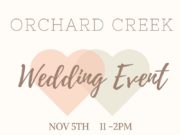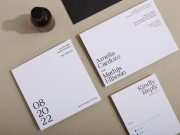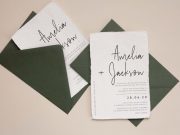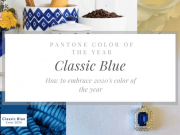[ad_1]
Deciding upon your wedding invitation printing technique is no easy feat. Printing options are vast and with so many possibilities it can be difficult to whittle down your options. When deliberating wedding invitation ideas, the actual process of printmaking may not be at the forefront of your mind. There are so many other things to take into consideration: perhaps you are looking for a specific style, theme or location, and have become set on finding a Brisbane wedding invitation vendor who creates vintage look wedding cards, for example. This sounds more than specific enough, but it’s actually overlooking one of the most important factors! Wedding invitations bridge the gap between you and your guests, so the message they portray is of high importance. Each of the various printing methods conveys a different sentiment; traditional or cutting-edge, sophisticated or fun, formal or casual, extravagant or elegant.
Although the range of printing techniques is seemingly endless, there are four clear leaders in terms of wedding invitations; letterpress, hot foil stamping, digital (“flat printing”) and laser-cut. What are they, what are the differences, and which is the right style for you? Not only do you need to consider the aesthetics of each printing technique but also the paper type it dictates you use, the design limitations you may have, and of course the dent it will make in your wallet.
Letterpress
What is it? Letterpress is the oldest traditional printing technique, dating back to the fifteenth century. However, over the past couple of years Letterpress has taken over the modern market and has fast become the go-to printing option for high-end stationery. Running your hand over the paper, you will feel the indented design below the surface. The indentation method lends itself well to thick, high quality paper that can withstand the pressure of the printing process. Letterpress printing is a classic style that proposes tradition, sophistication and opulence. Although a specialised technique, Letterpress has become widely available and is the number one method for making an impression – both literally and metaphorically.
How is it produced? Letterpress printing utilises a movable type machine. A design is reproduced onto raised printing plates, which are then inked and stamped onto paper. The machine itself is almost like a typewriter and usually has pre-determined type styles and fonts. However, nowadays you can utilise your own designs, fonts and style to produce a truly unique print. Because the ink used for letterpress is thin, it can look grey or dull on certain backgrounds. It is best to stick to black or dark-coloured ink upon white or light-coloured paper. This will enable the design to pop, as opposed to being washed out.
How much does it cost? All this luxury comes with a higher-than-average price tag, as you are essentially creating your own unique stamp with the custom polymer plate. Letterpress Wedding Invitations look best on unusual textured paper which is another fee to factor in. It requires soft, thick card stock like cotton fibre or bamboo. This is because the precise patterns and lines won’t imprint well on thinner material. Like other printing techniques, it is more cost effective to print in larger quantities so the larger your guest list the better value you will get! Letterpress is certainly not the cheapest option, but arguably the one that will leave the most enduring impression.
What are the pros? Letterpress is about timelessness – far from a fad or a fleeting trend, your letterpress wedding invitation will impress your guests with grandeur. Letterpress wedding invitations have been in the limelight lately as they exhibit quality in an old-style without being old-fashioned. The process is steeped in history and tradition, and the tactility of the finished product oozes quality. Letterpress is an art in itself and requires a high level of skill. This ensures that your wedding invitation will be treasured forever.
What are the cons? The particular method of Letterpress printing only allows for one colour at a time; more colours equate to a much higher cost. However, Letterpress is all about producing a clean and classic design that evokes simplicity so choosing only one or two colours often has a better outcome.
Well suited to: Vintage wedding invitations. If you want a vintage-themed wedding, then Letterpress is probably best suited for you. It creates an air of formality and elegance whilst retaining simplicity. Check out ‘Five of the Best Letterpress Wedding Invitations of 2015’ for some of our favourite Letterpress designs.
Source: https://cdn.bodasnovias.com/wp-content/uploads/2014/06/FOILED-2.jpg
You can customise and purchase this invitation here: https://paperlust.co/browse/wedding-invitations/
Source: https://www.bespokepress.com.au/images/wedding%20invitations/emily_paul_std_4.jpg
Hot foil stamping
What is it? Foil stamping or printing is a unique process that uses solid, metallic colours and creates a slight impression onto paper. You will see a shimmery indentation in the form of your design. Although nothing says ultra-elegance like gold foil, there is no shortage of other shades to choose from; silver, white, copper, black, pink, purple… Like Letterpress, foil wedding invitations require a heavy, high-quality paper to withstand the indentation of the print. It is an ideal printing method to use if you want to impress your guests with luxury, indulgence and elegance. Foil stamping appears to be a pretty extravagant printing method – all the connotations surrounding gold foil make us think of gold leaf, royalty and wealth. Combine this with contemporary design and you have a wedding invitation to remember.
How is it produced? Foil printing uses heat. It is considered ‘dry’ printing because the process does not require any ink. The wedding invitation design is sent through as a PDF and produced onto an artwork plate. This is usually made out of magnesium. When it is ready for print, the plate or block will be fixed to the foiling machine and positioned above the desired colour foil. It is then heated on press, before picking up a film of foil which has perfectly transferred to the paper. Et voila – we have a beautiful foil stamped wedding invitation!
How much does it cost? Although the flashy gold finish looks extremely expensive, it is only marginally dearer than Letterpress. You do have to consider the paper quality, however. As with Letterpress, foil stamping requires a slightly heavier grade which can be costly. Yet considering the striking finish of a foil stamped wedding invitation, we think it’s worth every penny.
What are the pros? This particular method appears to be extremely creative and a little different from ordinary matte design, which is why it’s also extremely popular for business cards. Metallic foils have a shiny, lustrous finish that catch the eye and won’t fail to impress your guests. Foil stamping also lends itself well to a blank canvas – simple gold lettering on white paper works a treat. The method complements a luxe, romantic wedding.
What are the cons? If you need to get your wedding invitations printed quickly, it’s probably best to forget foil stamping unless you’re willing to pay for the quick turnaround. Foil stamping is pretty time consuming so not ideal if you’re under time constraints or on a tight budget. Don’t forget to factor in processing and shipping time when considering this. If you need your invitations delivered to Brisbane but the printer is in Adelaide this can make a big difference if time is of the essence, compared with Brisbane wedding invitations being delivered within the city. You’re also pretty limited with how many colours you can use when opting for foil, but to be honest, multi-coloured metallic wedding invitations never did look all that great anyway.
Well suited to: Art Deco wedding invitations. The glitz and glamour of 1920s American life can be recreated through the medium of foil. This massive design trend looks fantastic when produced with the foil stamping printing technique. Art Deco design typically lends itself well to stain glass windows, bold jewellery and statement architecture. Reiterate the notions of this bygone age through your wedding invitations. Have a look at ‘The Gatsby Effect: A Look at Art Deco Wedding Invitations’ for a deeper insight into this popular theme.
You can customise and purchase this invitation here: https://paperlust.co/browse/wedding-invitations/foil-stamp/
You can customise and purchase this invitation here: https://paperlust.co/cascade-design/270/wedding-invitations–foil-stamp–minimalist-spot-invitation/
You can customise and purchase this invitation here: https://paperlust.co/cascade-design/705/wedding-invitations–foil-stamp–xo-invitations/
Digital printing
What is it? Sometimes referred to as “flat printing”, digital print produces just that – a flat image. Flat printing can also encompass offet printing, which is an older method traditionally used for large runs. With the advent of digital print over the past two decades, it has become the preferred print method, as it requires little in the way of set up costs. Although it’s possible to print at home on a laser printer, the results are often faded and smudged. Professional printers offer high quality products with a massive selection of colours and designs. Digital printing is ideal for imaginative and artistic wedding invitations. You are not restricted to a select few colours or typestyles like the other printing methods. With digital printing, you’re even able to reproduce the effects of painting techniques like watercolour, or pen and ink calligraphy. If you want absolute freedom with your wedding invitation design, then digital printing is definitely something you should look into.
How is it produced? Digital printing is done with a high quality laser printer, which uses thousands of tiny dots to form letters and designs on the paper. Designs are sent to the printer via a PDF document and there you have it – beautiful, vibrant prints!
How much does it cost? This is probably the best option for brides on a budget. Digital printing is the least expensive printing option with the quickest turnaround time. It’s typically done on thinner paper that’s flexible enough to be sent through a printer, which usually equates to cheaper costs. If your mind is full of crazy designs and colours, you’re most likely able to recreate that via digital printing. You can really go wild with typestyle as you’re not limited by the thickness of line.
What are the pros? You have an enormous amount of flexibility in terms of the number of colours you can choose. Since plates are not required, this is a fast and inexpensive option for many brides looking for vibrant colour options. Another plus point is that digital printing only requires a few days for production and shipping, so if you’ve left your wedding invitations to the last minute you needn’t fret!
What are the cons? There is no interesting texture to a digital print. It will be completely 2D with no raised lettering. If this doesn’t bother you, then great! The flexibility you receive in terms of design certainly makes up for the lack of indentation in the paper. Another issue to consider, however, is that you’re limited to thinner paper. Few companies are able to print on thicker, more expensive cotton fibre or bamboo.
Well suited for: Unique wedding invitations. Digital printing is all about the design. Take advantage of your printing freedom and go for something truly unique. At Paperlust, we source independent designers from cities all around Australia: from Melbourne to Brisbane, Perth to Sydney: the cream of the crop, to produce cutting edge, fresh invitation designs. Digital printing is best for creating unique wedding invitations with a contemporary edge, as well as being beautiful showcases of modern graphic design.
You can customise and purchase this invitation here: https://paperlust.co/cascade-design/686/wedding-invitations–digital-cards–geometric-diagonal-invitations/
You can customise and purchase this invitation here: https://paperlust.co/cascade-design/76/wedding-invitations–digital-cards–floral-circle-invitation-set–invitation/
You can customise and purchase this invitation here: https://paperlust.co/cascade-design/625/wedding-invitations–digital-cards–jeesa-invitations/
Laser-cut
What is it? Laser cut wedding invitations is a trend that has become massively popular over the past couple of years. Rather than featuring ink as the main design element, laser-cut produces paper with intricate motifs cut right in, ink-free! This high-tech skill can also be applied to other materials. Wood is a dramatic and beautiful material to laser cut, offering itself to an earthy and natural wedding style. The actual invitations are very delicate and sometimes require special casing or packaging.
How is it produced? Typically used in the manufacturing industry, the practice of laser-cutting has leaked into the stationery industry and become extremely desirable. Far from an easy DIY job, designers now employ a technological method that uses a laser to cut and etch shapes into various materials. Laser paper cutting machines not only cut paper but can engrave logos or pictures into thicker substances.
How much does it cost? The cost is entirely dependent on the design – the more detailed the design, the more time it takes to cut and therefore the dearer it will be. The most remarkable laser-cut wedding invitations are certainly the most detailed, so therefore this is not a very cost effective option. If you’re having an intimate wedding however, laser-cut wedding invitations would certainly reiterate the ‘quality not quantity’ approach.
What are the pros? Laser-cut invitations are show-stoppers in their intricacy and a great way for designers to show off their talents. Lasers are particularly suited for reproducing even the most elaborate of designs with maximum precision and quality – something a cutting plotter is unable to do. Laser-cutting produces super clean, precise designs that other printing methods struggle to achieve.
What are the cons? Laser-cut invitations aren’t usually well-suited for larger weddings due to the cost implications (but hey, if you have the budget for it, don’t let us stand in your way!). You also have to be careful as to what paper you use, because it is possible for it to burn and tear under the heat of the laser. The turnaround is quite slow due to length of time it takes to create a cut from scratch, which often includes an element of trial-and-error in terms of paper thickness.
Well suited to: Lace wedding invitations. As many wedding stationery trends evolve directly from wedding fashion itself, laser-cut invitations look great when mimicking the lace from a wedding gown or veil.
Source:
https://s-media-cache-ak0.pinimg.com/736x/8f/46/e4/8f46e47ff189c7ea91a9d3dbfda32cd6.jpg
Source:
https://s-media-cache-ak0.pinimg.com/736x/45/b6/43/45b6431b955e94cb65ca43e96f6ea092.jpg
Source:
https://s-media-cache-ak0.pinimg.com/736x/c9/56/16/c95616ac21574547caca52ace1347181.jpg
So there we have it! An explanation of the key wedding invitation printing techniques you are bound to come across on your search for the perfect wedding invitation. In the 21st century it is so easy to be tempted by online wedding invitations not lest to save money but time as well. Yet there is nothing quite like opening up an envelope addressed to yourself to reveal a beautiful piece of art. The art of printmaking has been the crux of all knowledge for hundreds of years, from the first editions of the Bible to Japanese woodblock prints. Looking into printing techniques also brings us into deeper consideration about the paper we use for wedding invitations – nasty A4 just won’t cut the mustard. Something wonderful happens when you can see the fibres within a sheet of lux paper and remember that it is from a tree; a notion of romanticism and timelessness. At Paperlust, we love paper – it is a work of art in itself and the tactility of a finished wedding invitation evokes emotions that simply can’t be conveyed digitally. We hope this article is useful in opening your eyes to the various printing techniques on offer, and for helping you choose a wedding invitation to remember. If you are after inspiration for your printing type, click here to sample our wedding invitations.
[ad_2]
Source link














































